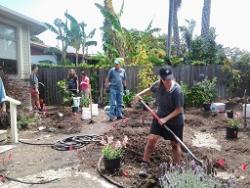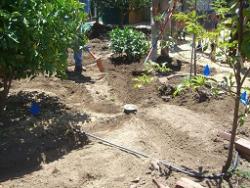But wait! Nothing will grow, and there’ll be no harvest, because you’re missing that one essential element that sustains life—one that we can’t do without. What’s that, you ask? Water!
Water availability, use and reuse are essential elements in any local sustainable food system. We need to get our water right to get our food right.
Fifty percent of water used in southern California goes to our landscapes. We use drinking water to flush our toilets. In our Mediterranean climate, we have rain in the winter and a long dry season. We cannot create food security without creating water security. A full Lake Cachuma today does not mean replenished aquifers. For long term sustainability, we need to plan how to make the most of our water.

But solutions abound! For every inch of rain that falls on a 1000 square foot roof, we can capture 600 gallons of water through a variety of means. We can create rain gardens to store water in the soil, helping edible plants survive between the rains. We can install rain tanks so that we can use the rainwater when we need it, on the plants that need it. Greywater, which includes all reused water from homes with the exception of that which comes from toilets, comprises 50 to 80 percent of residential waste water. We can direct this reclaimed water to the landscape, where it can nourish fruit trees and other food crops, so long as it doesn’t come in direct contact with any edible parts.
Here in Santa Barbara, Sweetwater Collaborative is leading the way. By offering hands-on workshops that install water harvesting and other sustainable systems in people’s homes and neighborhoods, we are bringing community together and setting the stage for long-term local food and water resilience.
Join us! We need both workshop hosts and volunteers to work, play, and learn with us. We are currently figuring out how to best offer our wisdom in ways that keep our community save from COVID19. Reach out if you want more info.
This article was originally published at http://solfoodfestival.com/2013/09/12/water-harvesting-to-enhance-food-production/#more-881'


